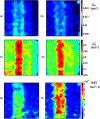Mapping breast cancer blood flow index, composition, and metabolism in a human subject using combined diffuse optical spectroscopic imaging and diffuse correlation spectroscopy
- PMID: 28384703
- PMCID: PMC5381696
- DOI: 10.1117/1.JBO.22.4.045003
Mapping breast cancer blood flow index, composition, and metabolism in a human subject using combined diffuse optical spectroscopic imaging and diffuse correlation spectroscopy
Abstract
Diffuse optical spectroscopic imaging (DOSI) and diffuse correlation spectroscopy (DCS) are model-based near-infrared (NIR) methods that measure tissue optical properties (broadband absorption, ? a , and reduced scattering, ? s ? ) and blood flow (blood flow index, BFI), respectively. DOSI-derived ? a values are used to determine composition by calculating the tissue concentration of oxy- and deoxyhemoglobin ( HbO 2 , HbR), water, and lipid. We developed and evaluated a combined, coregistered DOSI/DCS handheld probe for mapping and imaging these parameters. We show that uncertainties of 0.3 ?? mm ? 1 (37%) in ? s ? and 0.003 ?? mm ? 1 (33%) in ? a lead to ? 53 % and 9% errors in BFI, respectively. DOSI/DCS imaging of a solid tissue-simulating flow phantom and
Figures






References
-
- Yodh A., Chance B., “Spectroscopy and imaging with diffusing light,” Phys. Today 48(3), 34–40 (1995).PHTOAD10.1063/1.881445 - DOI
MeSH terms
Substances
Grants and funding
LinkOut - more resources
Full Text Sources
Other Literature Sources
Medical
Miscellaneous

